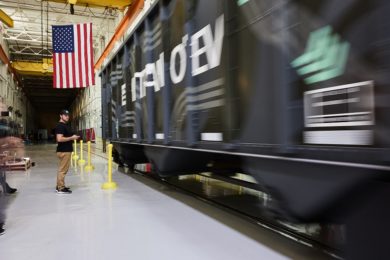There is a need to challenge conventional thinking around chute systems and transfer points according to Weba Chute Systems, especially seeing that most problems associated with transfer points can be eliminated during the design stage. Weba Chute Systems’ extensive experience and technical expertise, coupled with its broad applications knowledge, has positioned it as the leader in its field, says Mark Baller, Managing Director. “The expertise of chute manufacturers is useful during the design stages of a project to eliminate potential flow and maintenance problems at a later stage.”
By the very nature of their application, transfer points should be accorded the same level of importance as any other machinery involved in mineral processing. “It is interesting to note that transfer points can contribute to some of the highest maintenance costs on a mine, and yet engineers often do not view transfer point systems as a critical element of the minerals processing system,” Baller argues.
Traditional conveyor system design focused more on the structural integrity of the system and the selection of mechanical components. However, the design of the actual transfer points was considered to be of secondary importance, in addition to being constrained by a lack of design analysis of the material flow characteristics and needs. The end result is a plethora of inefficient and expensive transfer points.
“It is critical to consider basic chute specifications when addressing a material transfer problem, which necessitates a thorough knowledge of transfer point design as well as the ability to determine best practice for an application and the willingness to customise each design to these specific requirements,” Baller says.
The Weba Chute System is a concept that has been pioneered to cater for all of these factors. It is based on the lined ‘super tube’ or cascade system which results from those occasions when material runs on material.
“We have proved through numerous successful installations of Weba Chute Systems that the correct use of our streamlined scientific approach to the dynamics of bulk materials handling can completely eliminate the problems associated with conventional transfer chutes resulting in significant cost savings,” Baller explains.
To date the company has engineered over 4,000 transfer chutes that are operating successfully throughout the global mining industry. The Weba Chute System eliminates the problems associated with conventional transfer chutes as well as providing a cost effective and environmentally friendly solution for material transfer. The key to a successful project begins with a comprehensive site visit. Weba Chute Systems will consult with the plant engineers and maintenance staff to ensure that the end product meets all of their requirements, as well as complying with all safety, health, environment and quality requirements. This incorporates the operation’s unique product specifications and data, belt width and speed, material size and shape and throughput as well as the plant layout, including the position of belt scrapers and dust suppression/extraction systems.
“We consider a holistic design that does not only focus on the entry and exit points, but also incorporates the control of the flow, volume and velocity of the material being transferred at all times,” Baller says. Weba Chute Systems owns the intellectual property on a wide variety of transfer point designs.
System design is undertaken using sophisticated 3D computer software and data received. The company is ISO 9001:2008 accredited to ensure quality of manufacture. Performance is guaranteed in accordance with operational and application parameters, ensuring the provision of a chute solution that works for every application.









